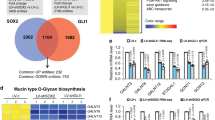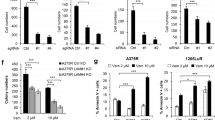Abstract
Acquisition of invasive/metastatic potential is a key event in tumor progression. Cell surface glycoproteins and their respective matrix ligands have been implicated in this process. Recent evidence reveals that the secreted glycoprotein SPARC (secreted protein, acidic and rich in cysteine) is highly expressed in different malignant tissues. The present study reports that the suppression of SPARC expression by human melanoma cells using a SPARC antisense expression vector results in a significant decrease in the in vitro adhesive and invasive capacities of tumor cells, completely abolishing their in vivo tumorigenicity. This is the first evidence that SPARC plays a key role in human melanoma invasive–metastatic phenotype development.
This is a preview of subscription content, access via your institution
Access options
Subscribe to this journal
Receive 12 print issues and online access
$209.00 per year
only $17.42 per issue
Buy this article
- Purchase on Springer Link
- Instant access to full article PDF
Prices may be subject to local taxes which are calculated during checkout
Similar content being viewed by others
References
Stetler-Stevenson, W.G., Aznavoorian, S. & Liotta, L.A., Tumor Cell interactions with the extra Cellular matrix during invasion and metastasis. Annu. Rev. Cell Biol. 9, 541–573 (1993).
Stetler-Stevenson, W.G., Liotta, L.A. & Kleiner, D.E., Cellular matrix 6: Role of matrix metalloproteinases in tumor invasion and metastasis. FASEBJ. 7, 1434–1441 (1993).
Albelda, S.M. Role of integrins and other Cell adhesion molecules in tumor progression and metastasis. Lab. Invest. 68, 4–17 (1993).
Wewer, U.M., Taraboletti, G., Sobel, M.E., Albrechtsen, R. & Liotta, L.A. Role of laminin receptors in tumor Cell migration. Cancer Res. 47, 5691–5698 (1987).
Lane, T.F. & Sage, E.H. The biology of SPARC, a protein that modulates Cell-matrix interactions. FASEB J. 8, 163–173 (1994).
Sage, E.H. & Bornstein, P., Cellular proteins that modulate Cell-matrix interactions. J. Biol. Chem. 266, 14831–14834 (1991).
Tremble, P.M., Lane, T.F., Sage, E.H. & Werb, Z. SPARC, a secreted protein associated with morphogenesis and tissue remodelling, induces expression of metalloproteinases in fibroblasts through a novel extraCellular matrix-dependent pathway. J. Cell Biol. 121, 1433–1444 (1993).
Porter, P.L., Sage, E.H., Lane, T.F., Funk, S.H. & Gown, A.M. Distribution of SPARC in normal and neoplastic tissue. J. Histochem. Cytochem. 43, 791–800 (1995).
Podhajcer, O.L. et al. Comparative expression of the SPARC and stromelysin-3 genes in mammary tumors. Breast 5, 13–20 (1996).
Bellahcene, A. & Castronovo, V. Increased expression of osteonectin and osteopontin, two bone matrix proteins, in human breast cancer. Am. J. Pathol. 146, 95–100 (1995).
Porte, H. et al. Neoplastic progression of human colorectal cancer is associated with overexpression of the stromelysin-3 and BM-40/SPARC genes. Int. J. Cancer 64, 70–75 (1995).
Ledda, F. et al. The expression of the secreted protein acidic and rich in cysteine, SPARC, is associated with the neoplastic progression of human melanoma. J. Invest. Dermatol. (in the press).
Podhajcer, O.L. et al. Expression of cathepsin D in primary and metastatic human melanoma and dysplastic nevi. J. Invest. Dermatol. 104, 340–144 (1995).
Terranova, V.P., Williams, J.E., Liotta, L.E. & Martin, G.R. Modulation of the metastatic activity of melanoma Cells by laminin and fibronectin. Science 226, 982–985 (1984).
Kanemoto, T. et al. Identification of an amino acid sequence from the laminin A chain that stimulates metastasis and collagenase IV production. Proc. Natl. Acad. Sci. USA 87, 2279–2283 (1990).
Seftor, R.E.B. et al. Role of the αvβ3 integrin in human melanoma Cell invasion. Proc. Natl. Acad. Sci. USA 89, 1557–1561 (1992).
Seftor, R.E.B., Seftor, E., Stetler-Stevenson, W.G. & Hendrix, M.J.C. The 72 kDa type IV collagenase is modulated via differential expression of αvβ3 and α5β1 integrins during human melanoma invasion. Cancer Res. 53, 3411–3415 (1993).
Sage, E.H., Vemon, R.B., Funk, S.E., Everitt, E.A. & Angello, J. SPARC, a secreted protein associated with Cellular proliferation, inhibits Cell spreading in vitro and exhibits Ca2+-dependent binding to the extraCellular matrix. J. Cell Biol. 109, 341–356 (1989).
Lane, T.F., Iruela-Arispe, M. & Sage, E.H. Regulation of gene expression by SPARC during angiogenesis in vitro. Changes in fibronectin, thrombospondin-1 and plasminogen activator inhibitor-1. J. Biol. Chem. 267, 16736–16745 (1992).
Kamihagi, K., Katayama, M., Ouchi, R. & Kato, I. Osteonectin/SPARC regulates extraCellular secretion rates of fibronectin and laminin extra Cellular matrix proteins. Biochem. Biophys. Res. Common. 200, 423–428 (1994).
Maurer, P. et al. High-affinity and low-affinity calcium binding and stability of the multidomain extraCellular 30-kDa basement membrane glycoprotein (BM-40/SPARC/osteonectin). Eur. J. Biochem. 205, 233–240 (1992).
Lane, T.F. & Sage, E.H. Functional mapping of SPARC: Peptides from two distinct sites modulate Cell adhesion. J. Cell Biol. 111, 3065–3076 (1990).
Pottgiesser, J. et al. Changes in calcium and collagen II binding caused by mutations in the EF hand and other domains of extraCellular matrix protein BM-40 (SPARC, osteonectin). J. Mol. Biol. 238, 563–574 (1994).
Funk, S.E., Sage, E.H. Differential effects of SPARC and cationic SPARC peptides on DNA synthesis by endothelial Cells and fibroblasts. J. Cell Physiol. 154, 53–63 (1993).
Lane, T.F., Iruela-Arispe, M.L., Johnson, R.S. & Sage, E.H. SPARC is a source of copper-binding peptides that stimulate angiogenesis. J. Cell Biol. 125, 929–943 (1994).
Kochevar, G.J., Stanek, J.A. & Rucker, E.B. Truncated fibronectin. An autologous growth-promoting substance secreted by renal carcinoma Cells. Cancer 69, 2311–2315 (1992).
Lambert Vidmar, S., Lottspeich, F., Emod, Y., Planchenault, T. & Kleil-Dlouha, V. Latent fibronectin-degrading serine proteinase activity in N-terminal heparin-binding domain of human plasma fibronectin. Eur. J Biochem. 201, 71–77 (1991).
Mok, S.C., Chan, W.Y., Wong, K.K., Muto, M.G. & Berkowitz, R.S. SPARC, an extraCellular matrix protein with tumor-suppressing activity in human ovarian epithelial Cells. Oncogene 12, 1895–1901 (1996).
Funk, S.E. & Sage, E.H., Ca2+-binding glycoprotein SPARC modulates Cell cycle progression in bovine aortic endothelial Cells. Proc. Natl Acad. Sci. USA 88, 2648–2652 (1991).
Everitt, E.A. & Sage, E.H. Expression of SPARC is correlated with altered morphologies in transfected F9 embryonal carcinoma Cells. Exp. Cell Res. 199, 134–146 (1992).
Oppenheim, J.J., Zachariae, C.O.C., Mukaida, N. & Matsushima, K. Properties of the novel proinflammatory supergene intercrineo cytokine family. Annu. Rev. Immunol. 9, 617–648 (1991).
Gilat, D., Cahalon, L., Harshkovitz, R. & Lider, O. Interplay of T Cells and cytokines in the context of enzymatically modified extraCellular matrix. Immunol. Today, 17, 16–20 (1996).
Mercola, D. & Cohen, J.S. Antisense approaches to cancer gene therapy. Cancer Gene Ther. 2, 47–59 (1995).
Trojan, J. et al. Treatment and prevention of rat glioblastoma by immunogenic C6 Cells expressing antisense insulin-like growth factor I RNA. Science 259, 94–97 (1993).
Laird, A.D., Brown, P.I. & Fausto, N. Inhibition of tumor growth in liver epithelial Cells transfected with a transforming growth factor α antisense gene. Cancer Res. 54, 4224–232 (1994).
Aoki, K., Yoshida, T., Sugimura, T. & Terada, M. Liposome-mediated in vivo gene transfer of antisense K-ras construct inhibits pancreatic tumor dissemination in the murine peritoneal cavity. Cancer Res. 55, 3810–3816 (1995).
Harlow, E. & Lane, D., Immunizationax. in: Antibodies: A Laboratory Manual. Ch. 5, 53–138 (Cold Spring Harbor Laboratory, Cold Spring Harbor, New York, 1988).
Rao, J.S. et al. Elevated levels of M, 92,000 type IV collagenase in human brain tumors. Cancer Res. 53, 2208–2211 (1993).
Yabkowitz, R., Mansfield, P.J., Dixit, V.M. & Suchard, S.J. Motility of human carcinoma Cells in response to thrombospondin: Relationship to metastatic potential and thrombospondin structural domains. Cancer Res. 53, 378–387 (1993).
Collier, I.E. et al. H-ras oncogene-transformed human bronchial epithelial Cells (TBE-1) secrete a single metalloprotease capable of degrading basement membrane collagen. J. Biol. Chem. 263, 6579–6587 (1988).
Author information
Authors and Affiliations
Rights and permissions
About this article
Cite this article
Ledda, M., Adris, S., Bravo, A. et al. Suppression of SPARC expression by antisense RNA abrogates the tumorigenicity of human melanoma cells. Nat Med 3, 171–176 (1997). https://doi.org/10.1038/nm0297-171
Received:
Accepted:
Issue Date:
DOI: https://doi.org/10.1038/nm0297-171
This article is cited by
-
Regulatory pathway analysis of coat color genes in Mongolian horses
Hereditas (2018)
-
Proteomic profiling identifies markers for inflammation-related tumor–fibroblast interaction
Clinical Proteomics (2017)
-
In phyllodes tumors of the breast expression of SPARC (osteonectin/BM40) mRNA by in situ hybridization correlates with protein expression by immunohistochemistry and is associated with tumor progression
Virchows Archiv (2017)
-
Tumour-derived SPARC drives vascular permeability and extravasation through endothelial VCAM1 signalling to promote metastasis
Nature Communications (2015)
-
Regulation of Fibulin-2 Gene Expression by Integrin α3β1 Contributes to the Invasive Phenotype of Transformed Keratinocytes
Journal of Investigative Dermatology (2014)



